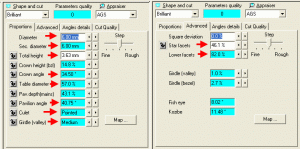- Joined
- Mar 28, 2001
- Messages
- 6,341
Greetings Pricescope friends.
I see a a lot of people who come on and learn about DiamCalc and ask for results or possible models/simulated IdealScope images/MSU Cut Quality Ratings of what their potential stones may appear to be like and alot go unanswered. There are a few reasons for this.
#1 The person you're considering purchasing from should get off their duff and INVEST in their own business and buy the program themselves so they can better serve their clients.
#2 Those of us who do have it are busy helping our clients and with the little time we have in the day don't see why we should help our comptetition.
#3 And this I think is the primary reason (for those of us who do indeed want to help). Most consumers do not give nearly enough information for us to even come close to an accurate representation or educated opinion of what you may or may not have.
So ... for those of you who want to help us help you I've developed this little chart that are aspects we NEED to better serve you if you're looking for any kind of quasi-educated input.
In the chart on the left, all the aspects pointed to in the RED ARROWS are absolutely necessary and are minimums. The RED ARROWS in the graphic on the right would also be nice but we realize very very few labs can provide that information (ours being one that can).
In our shop after we Sarin a diamond we can actually import the actual 3d model of that diamond into the DiaCalc software and can render a .gem file of the actual stone no matter what shape it is. The more I work with this hardware/software combo the more I realize how utterly important it is to know not only the basic information but also the minor facet information AND THE DEVIATIONS that exist from facet to facet. Indeed when I respond to DiamCalc post/requests I always show 2 variations that can exist within the specs the person gives as the changing of the minor facets and deviations can make the stone appear to be something totally different than what Rich Sherwood, myself or any other gemologist can produce with the DiamCalc software. A scan of the stone with it's actual model is really the way to go.
Hope this helps.
Peace,
Rhino

I see a a lot of people who come on and learn about DiamCalc and ask for results or possible models/simulated IdealScope images/MSU Cut Quality Ratings of what their potential stones may appear to be like and alot go unanswered. There are a few reasons for this.
#1 The person you're considering purchasing from should get off their duff and INVEST in their own business and buy the program themselves so they can better serve their clients.
#2 Those of us who do have it are busy helping our clients and with the little time we have in the day don't see why we should help our comptetition.
#3 And this I think is the primary reason (for those of us who do indeed want to help). Most consumers do not give nearly enough information for us to even come close to an accurate representation or educated opinion of what you may or may not have.
So ... for those of you who want to help us help you I've developed this little chart that are aspects we NEED to better serve you if you're looking for any kind of quasi-educated input.
In the chart on the left, all the aspects pointed to in the RED ARROWS are absolutely necessary and are minimums. The RED ARROWS in the graphic on the right would also be nice but we realize very very few labs can provide that information (ours being one that can).
In our shop after we Sarin a diamond we can actually import the actual 3d model of that diamond into the DiaCalc software and can render a .gem file of the actual stone no matter what shape it is. The more I work with this hardware/software combo the more I realize how utterly important it is to know not only the basic information but also the minor facet information AND THE DEVIATIONS that exist from facet to facet. Indeed when I respond to DiamCalc post/requests I always show 2 variations that can exist within the specs the person gives as the changing of the minor facets and deviations can make the stone appear to be something totally different than what Rich Sherwood, myself or any other gemologist can produce with the DiamCalc software. A scan of the stone with it's actual model is really the way to go.
Hope this helps.
Peace,
Rhino






300x240.png)